LG MR462ULT-G Handleiding
Bekijk gratis de handleiding van LG MR462ULT-G (2 pagina’s), behorend tot de categorie Koelkast. Deze gids werd als nuttig beoordeeld door 64 mensen en kreeg gemiddeld 4.7 sterren uit 32.5 reviews. Heb je een vraag over LG MR462ULT-G of wil je andere gebruikers van dit product iets vragen? Stel een vraag
Pagina 1/2

O
P
S
T
U
W
X
A
B
C
D
F
J
K
L
M
G
H
N
V
I
Q
R
www.lg.com
2
4. WATER DISPENSER
Your refrigerator has a mechanism that dispatches cool water
without open the door.
NOTE: Use only water (do not add sugar). Any other kind of liquid
can cause damage on the mechanism.
To obtain water, push upward the dispenser lever with a glass
until water start flows (Figure 14). After dispensing water, remove
slowly the glass from the lever in order to avoid dripping.
Tray
• The tray can be removed easily by holding and sliding it out,
see Figure 15.
• To reinstall the tray, just slide it in (Figure 16).
• Keep fresh food in the refrigerator.
• Freeze only small amounts of food.
• After you freeze some food, once you thaw it do not freeze them again, they loose their taste and nutritional value;
after thawing them, you might keep them in the refrigerator up to 48 hours.
• Do not store food that might get decomposed under low temperatures (like pineapple, bananas and cantaloupe).
• Do not store garlic in the refrigerator.
• When storing food in the refrigerator use closed containers to avoid odor mixing and loosing of humidity.
• Always clean the food before placing them in the refrigerator. Wash and dry the fruits and vegetables.
• It is recommendable to store onion in plastic bags to avoid other food odor to get mixed with it odor.
• If your are going to store ice cream for a long period of time, place it on the freezer grid and not on the freezer door.
• When storing eggs always place them in the highest shelf or in the first compartment in order to keep them fresh for
a longer period of time.
• Throw away any food that is being decomposed; it may contaminate other foods.
• Store cold cuts, cheese and sausages in bags or plastic sealed containers.
• Do not store glass bottles in the freezer because they can break when they freeze.
• Do not store hot food inside the refrigerator they might decrease the refrigerator’s efficiency.
• In the models with water dispenser it is recommended that you change the water at least every 7 days.
In order to avoid bad or unwanted odors, is important to keep the refrigerator clean. Any spilled food must be cleaned immediately; they
can stain and/or acidify the plastic parts of the refrigerator if they are let to get dry.
WARNING. Unplug the power plug always before cleaning around the electrical parts (lamps, switches, etc.) Clean any humidity to
avoid any liquid might get into any electrical part. Do not touch the frozen part with wet hands, humid or wet object stick to frozen
surfaces.
Exterior
Use a warm mixture of mild detergent or soap to clean the refrigerator’s surface. Clean with a damp cloth and dry immediately.
Interior
It is recommended to clean the interior often. Wash all the baskets and compartments with a mixture of bicarbonate or mild detergent
with water. Clean and dry. Using other kinds of products might damage your refrigerator.
After Cleaning
Verify that ground connection is not damaged or overheated, also check that is properly connected.
Ice Tray Kit “Indoor Ice Maker”
• Remove the ice tray from the kit, see Figure 17.
• Clean the inside and the outside of the tray with a mild soap, rinse with tap water (Figure 18).
• Pass a damp piece of cloth and then dry (Figure 19).
CAUTION. Do not immerse the ice tray in water. If done, completely dry the tray.
Door lining and gaskets
Use only a mild detergent (such as dish soap).
Plastic Parts
Do not use abrasive, paper or rough products. These could damage the product.
Back Cover
In order to get an efficient performance of your refrigerator, clean the rear part of it at least twice a year.
Water Container
1. Remove the water container, see Figure 20 (it is no necessary to empty it before remove).
2. Remove the container lid, opening the snaps and wash it with dish washing detergent.
3. Rinse thoroughly under water (Figure 21).
4. Wipe it with a clean cloth, Figure 22.
The refrigerator does
not work
• Check if any fuse is broken in the electric facility.
• Check if the power cord is correctly plugged.
• Check if the power outlet is not damaged.
• Identify if there are any high consume electrical appliances working at the same time, unplug the one
that are not necessary.
There is a power
interruption
• Check that no fuse is burned.
• Check if the power cord is plugged.
• Check that the outlet is not damaged.
• Identify weather you have different high consumption equipment plugged at the same time, unplug the
one you do not use.
In case of a black out, call your electric company and ask how long it will last.
• In case of a 24 hour or less black out, do not open the refrigerator; this will keep the food fresh.
• In case of a longer black out, do one of the following options:
1. 1. Pull out all of the frozen food and keep them in an ice chest.
2. Put 2 lbs (0, 907 Kg) of frozen ice (make sure you use gloves) for each square foot (28 L) inside the
freezer. This task will preserve the food for 2 to 4 days. While handling dry ice (CO
2), wear gloves to
protect your hands from frostbite.
3. In case you do not possess neither ice chest or dry ice (CO
2), consume your food as soon as possible.
The temperature of
the refrigerator or the
freezer is too warm
or hot
• Check that the temperature control is in the right position.
• Place the refrigerator away from any heat sources or direct sunlight.
• Open the doors only when necessary.
• There are too many food that block the air vents.
• Don’t let the doors open for too long.
I can hear some weird
or abnormal sounds
• Check that the refrigerator is placed over an even leveled surface, if not, adjust the refrigerator using the
leveling height adjusting screws.
• Remove the unnecessary object from the back or top of the refrigerator.
• Check that the voltage is the correct one, if not call your electric company.
There are some odors
in the refrigerator • Store all food in sealed containers.
• Frequently clean the refrigerator inside.
Some humidity
is formed in the
cabinet’s surface
• When the weather is humid is normal.
• The door might be opened, check that is properly closed.
The front part of the
refrigerator is getting
warm
• Do not worry, is part of the normal functioning of the refrigerator, and this happens in order to avoid
condensation or “sweat”.
• If this comes to happen, just clean with a dry piece of cloth.
The compressor
works too frequently
and for extended
periods of time
• Check if the temperature controls are place in the maximum, if so, place then in the middle.
• Check that the doors are properly closed.
• Do not store over heated products.
• Do not let the doors open for too long.
• Move away from any heat sources the refrigerator.
REMEMBER: In a power failure, a full freezer stays cold longer than a partially filled one. A freezer full of meat stays cold longer than a
freezer full of baked goods. If you see that food contains ice crystals, it may be safely refrozen, although the quality and flavor may be
affected. If the condition of the food is poor or if you feel it unsafe, dispose of it.
1. THE OVERALL PERFORMANCE OR EFFICIENCY OF YOUR REFRIGERATOR MIGHT BE AFFECTED IF:
• It is place near a heat source or humid area.
• You open the door frequently.
• If you introduce water or any object in the cold air vents.
2. DURING VACATIONS WE RECOMMENDED YOU THE FOLLOWING:
•Ifthevacationsareforashortperiodoftimeplacethefreezablefoodintherefrigerator.
•Ifyouaregoingtobeoutsideorawayforalongerperiodoftime,dothefollowing:
1. Take out all food.
2. Unplug the power cord.
3. Leave the doors open to avoid bad odors.
4. Thoroughly clean the refrigerator.
3. IF YOU ARE PLANNING TO MOVE OR TO CHANGE YOUR REFRIGERATOR
FROM ITS CURRENT POSITION:
• Remove and secure all attachments inside the refrigerator.
• To avoid any damage to the leveling height adjusting screws, turn then completely until
the base.
• Place the power cord in the hook located in the upper left side.
• Clean and empty the water container and do not forget to purge the system (turning on
the switch).
• After these procedures, you will be able to move your refrigerator.
• When you move your refrigerator, place a protection sheet, such as packing cartoon under
the refrigerator to avoid floor damage.
• Always pull your refrigerator straight out. Do not shift from side to side or “walk” the
refrigerator when you are moving it.
• Use the assistance of two or more persons to move or install the refrigerator. Not following
these instructions may cause injury to the back and other parts of the body.
4. LAMP REPLACEMENT
Your refrigerator has a LED Lamp, for replace or change it, you must call your Service Center,
this change only must be done by qualified technician.
WARNING. In case of replacement, the new lamp must be the same size and wattage as the
original.
5. THE FRONT AREA WARMS UP
The front wall of the cabinet of the refrigerator might warm up sometimes specially during installation.
DO NOT ALARM! It’s normal due to avoid humidity or “sweat”.
6. THE BACK OF THE REFRIGERATOR WARMS UP (some models)
The warming up is normal because from behind passes the cooling coil.
3
Figure 8. Refrigerator Internal Temperature
Control
(certain models)
Figure 7. Freezer Internal Temperature Control.
Turning knob (all models)
NOTE: Be careful of not blocking or moving with
food packages the temperature controls, you might
change or not recognize the temperature in which your
refrigerator is set.
MANUAL DE USUARIO
REFRIGERADOR CON
CONGELADOR SUPERIOR
Lea detenidamente este manual antes de empezar a utilizar el refrigerador
y guárdelo como referencia para el futuro.
ENGLISH
USING YOUR REFRIGERATOR
4
1
THIS MANUAL CONTAINS SEVERAL IMPORTANT SAFETY NOTICES. ALWAYS READ AND OBEY ALL OF THE
FOLLOWING SAFETY MESSAGES.
DANGER If you fail to follow these instructions you will be killed or seriously injured.
WARNING Misuses of the product will cause you physical damage or personal wounds.
CAUTION Inadequate use and installation will cause damage to your property.
All safety labels will inform you of potential danger, ways to reduce chance of injury and what can happen if instructions are not followed.
WARNINGS AND IMPORTANT SAFETY MEASURES
All safety labels will inform you of potential danger, ways to reduce chance of injury and what can happen if instructions are not followed.
CAUTION. This appliance is not intended for being used by children, persons with physical or mental
disabilities, persons with reduced sensory or mental capacity, or persons with lack of experience or know-how,
unless they have supervision or instruction in relation to the use of the appliance by the person responsible for
their safety. Children should be supervised to assure that they do not play with the appliance.
NEVER USE EXTENSION CORDS. Never connect multiple machines in the same socket, this can cause
wiring to overcharge, warming, voltage vibrations and bad functioning.
ELECTRICAL CORD REPLACEMENT. If electrical cord gets damaged it must be replaced by the manufacturer, our service
center or qualified LG Electronics personnel to minimize risks.
GROUND CONNECTION. In case of electrical surge, connection to ground will reduce risks of
electric shock hazard. This unit must be grounded. Consult a qualified electrician. When moving
your refrigerator, be careful not to step on the electrical cord with the machine’s rollers.
¡¡¡NEVER KEEP EXPLOSIVES INSIDE!!!. Never store explosive substances or chemicals in
your refrigerator such as benzene, alcohol, etc. It is DANGEROUS!!
DANGEROUS FUN. An empty refrigerator can be very dangerous for children. Remove doors or magnetic packaging
when not be in use or secure it in a way to make it impossible to open and allow a child to go in as this can lead to
suffocation. Never allow a child to climb, hang or play with the refrigerator compartments. They can get hurt themselves
and damage the refrigerator.
PLUG ACCESS. The refrigerator-freezer must be placed in a way that the electrical cord can be pulled easily in case of
emergency.
WHAT TO DO WITH YOUR OLD REFRIGERATOR. Your refrigerator contains liquids (refrigerant, lubricant) made of
recyclable materials. All these materials must be sent to a recycling waste disposal site as they can be reused after a specific
recycling process. Contact local authorities.
WHEN CLOSING REFRIGERATOR DOOR. Never place your thumb or fingers on the superior part of the
handle, as it can be pressed against the lower part of the freezer handle. Keep away all fingers from injury areas
such as where doors close cabinets and hinges, etc. Be careful when closing doors if children are nearby.
NEVER USE MECHANICAL DEVICES. Never use mechanical devices or any other means to
accelerate the thawing process, use only those which are approved by the manufacturer.
NEVER STORE ELECTRONIC DEVICES. Never use electronic equipment to store food unless they
are specific models approved by the manufacturer.
WARNING. The maintenance of the lower area from the refrigerator’s back side (see image) only must
be done by qualified personal, do it by non qualified technician can produce risk of electric shock.
NOTE: This guide covers different models. Your refrigerator could have some or all of the features and parts listed below. The location of
some of the parts may not correspond with your model.
Freezer Lamp (LED) *
Freezer Shelf (Plastic or Glass)
Temperature Control (Freezer)
Refrigerator Top Lamp (LED) *
External Temperature Control (Refrigerator) *
Internal Temperature Control (Refrigerator) *
Refrigerator Lamp (LED)
Refrigerator Shelf (Glass)
Cover for Vegetables & Fruits Compartment
Vegetables & Fruits Compartment
(“2 in 1 Box” or “1 Box”) *
Magic Crisper (Plastic)
Cover for vegetable drawer, it controls humidity
Vegetable Drawer
Keeps fruits and vegetables fresh
Vita Light *
Base Grille *
Freezer Big Basket
Ice @ Door (Ice Maker)
Home Bar (Ice Container)
Freezer Small Basket
Water Tank
Refrigerator Small Basket
Multi Flow Air Duct
Distributes air to all refrigerator compartments
Egg Tray
Refrigerator Big Basket
Leveling Screws
Water Dispenser
*Certain Models
Ice Tray
Freezer Shelf (Plastic)
Temperature Control (Freezer)
Temperature Control (Refrigerator)
Multi Flow Air Duct
Distributes air to all refrigerator compartments
Refrigerator Lamp (LED)
Refrigerator Shelf (Glass)
Magic Crisper
Cover for vegetable drawer, it controls humidity
Vegetable Drawer
Keeps fruits and vegetables fresh
Freezer Basket
Egg Tray
Refrigerator Basket
Leveling Screws
1. UNPACKING
Before installing your refrigerator, remove any tape or temporary stickers. Do not remove any stickers that feature warnings, the model
serial number or the technical label of the product located on the back of the refrigerator. To remove adhesive tape residue, rub it
well with your fingers and a little liquid detergent. Clean with warm water and let dry. Do not use sharp instruments, rubbing alcohol,
flammable liquids or abrasive cleaning products to remove the adhesive tape or glue. These products can damage the surface of your
refrigerator. The shelves come already installed in their factory position. Remove the shelves and replace
them according to your spacing needs.
2. INSTALL IT AWAY FROM HEAT SOURCES AND HUMID AREAS
In places with high temperatures, freezing capacity can be affected and cause high consumption of
electrical energy. Never install in places with high humidity as this can cause oxidation and electric shock
hazard.
SAFETY MEASURES
IDENTIFICATION OF PARTS
3. THOUGH AND EVEN FLOOR
Your refrigerator must be leveled and placed on a strong floor. An unstable installation can
produce noise and vibrations. If the floor is uneven, level the unit by twisting the height adjusting
screw, this will eliminate unwanted sounds and vibrations.
NOTE: Leveling screws can easily be turned by slightly tilting the front of the refrigerator, turn the
leveling screws clockwise ( ) to raise it and counter-clockwise ( ) to lower it.
4. AMBIENT TEMPERATURE
The refrigerator will work efficiently if room temperature is between 10 °C and 43 °C (50 °F and
109,4 °F).
5. A PROPER DISTANCE FROM ADJACENT ITEMS
Adequate air flow is needed for an efficient operation. Keep your refrigerator at a relative distance
from other objects. Reduced distances between the unit and other nearby objects can diminish
freezing capacity and rise consumption of electrical energy.
NOTE: Be careful when you open the doors, one of them can be opened more than the other one.
Avoid hit the doors with items around the refrigerator area.
6. WAITING PERIOD
Wait at least one hour before connecting, after installation was completed.
7. CONNECTION
DANGER. FOR YOUR PERSONAL SAFETY, this device must be properly grounded.
Connect to a single undamaged socket. Not having proper installation will require you to
call qualified personnel to achieve it.
Do not, under any circumstance, cut or extract the third prong from the plug. It is your
responsibility and obligation to replace two-prong outlets with that of an adequately
grounded three-prong outlet.
WARNING. REPLACING ELECTRICAL CABLE; if the power cord is damaged, it must
be replaced by our service center or qualified LG technician to avoid any risk. NEVER
disconnect the refrigerator by pulling the power cord, always grip the plug firmly and
disconnect it directly from the outlet.
8. BEFORE STORING FOOD
Leave it working from 2 h to 3 h before storing food. If operation is interrupted wait 5 min before trying again.
9. INSTALLATION OF BASE GRILLE (in some models)
Installing or Replacing the Base Grille:
1. Remove the 2 screws from the bottom front part of your refrigerator (in front).
2. Place base grille into position and insert and tighten screws, see Figure 1.
To remove the Base Grille:
1. Open the refrigerator’s door.
2. Once the door is open, remove screws from base grille and remove.
3. Remove the base grille.
4. Reattach screws to the base of refrigerator.
10. IN CASE OF UNINSTALLING
If you wish to dispose of your refrigerator, keep in mind the following WARNING.
WARNING. If the use of this unit is no longer needed, please contact local
authorities to dispose of this product in a safe way; as is Pentane-cycle or pentane like gas for insulation. Insulation gases require a
special elimination process. This product contains flammable insulation.
1. CONNECTION
Remember that your refrigerator must be grounded.
CAUTION. If operation is interrupted, wait 5 minutes before restarting it.
2. ICE MAKER OPERATION
“Ice @ Door”
• To make ice cubes, pull out the ice container and pour water on the shelves (Figure 1.) Then place in their original position until you
hear a “click” sound.
WARNING. Fill only with potable water.
WARNING. Make sure the level of water in the shelf is even on the entire surface, guiding yourself with pointing arrows on Figure
2. Water must not surpass this level as it can get spilled when opening or closing door.
• The ice maker takes around 4 hours to produce ice cubes. Check the ice status through the transparent panel.
• To remove ice cubes, carefully pull the drawer lever (Figure 3). The ice cubes will fall into the ice container (Figure 4).
WARNING. Refrain from pulling the lever before ice cubes have been completely made, as this can cause water to spill, freeze,
and cause the container to stick to the Ice maker (Figure 5). If water spills, immediately wipe it off with a cloth. Avoid heavy ice
accumulation in the container as this can cause problems to move the lever and/or container.
3. THAWING
Thawing occurs automatically, you do not need to worry about this. Thawed water will flow into the evaporation shelf at the back of the
refrigerator.
4. AUTO CHECK
Your refrigerator has the capacity of auto checking. If any failure comes to happen
a code will be displayed to help the technician for its repairing. While this code is
on display, the rest of the functions of control a visualizing will not be functioning.
NOTE: In the temperature controls, the code is represented with a no consecutive
blinking of the LED (left to right/down to up) as would be in the normal mode.
Example:
5. TEMPERATURE CONTROL SETTINGS
• Refrigerator temperature will always be the same, despite ambient temperature changes.
• We recommend not to change the temperature adjustments after they have been set unless it is necessary.
• This refrigerator contains a button which controls the refrigerator’s temperature and a knob to control the freezer’s temperature.
• The correct temperature configuration for the refrigerator compartment should be 37,4 °F (3 °C).
• The correct temperature configuration for the freezer compartment should be -2,2 °F (-19 °C).
• The refrigerator compartment contains a temperature sensor which will automatically start and stop the compressor functions as
needed.
5.1 External Temperature Control (in some models)
•Refrigerator: Monitors the refrigerator temperature. External temperature control, Figure 6, (certain models).
ENERGY SAVE: By pressing this button the refrigerator will work with minimal power, reducing the time it is spent used and energy
consumption. This feature will not activate if “EXPRESS FREEZING” is on.
DOOR ALARM: You will hear an alarm when the refrigerator or freezer door stays open for over a minute. The alarm will continue
with this sound every 30 seconds. NOTE: Freezer alarm is only available for 16 cubic feet capacity models. Alarm will stop once both
doors have been shut. By pressing the button, the alarm can be deactivated.
REFRIGERATOR: This feature allows you to adjust the refrigerator temperature. The number appearing on the screen will match the
degrees of the inside of the refrigerator. You can choose from 5 different settings, from 0 °C to 6 °C (32 °F to 42,8 °F).
EXPRESS FRZ: Once this button is pressed, the refrigerator will begin to cool at full power to a maximum of two 2 hours. Pressing
the button a second time will deactivate the mechanism. This feature will not be available if “ENERGY SAVE” is on.
Temperature Configuration
HOW TO ADJUST
COLDER RECOMMENDED COLD
Press the “REFRIGERATOR” button until
the bars reach the maximum limit and the
temperature indicator reads 32 °F (0 °C).
Press the “REFRIGERATOR” button
until the indicator reads 37,4 °F (3 °C).
This is the desired temperature for best
performance of this unit (Up to the third
bar will be lighted).
Press the “REFRIGERATOR” button until
the bars reach the minimum level. The
indicator will reads 42,8 °F (6 °C).
• Freezer: Controls the flow of cold air that goes from the freezer into the refrigerator.
NOTE: To check functions of the freezer temperature control, please look for Internal Temperature Control Function.
5.2 Internal Temperature Control
• Freezer: Controls the air flow from the freezer to the refrigerator, Figure 7.
HOW TO ADJUST COLDER RECOMMENDED COLD
To adjust the position knob turn to either
side to make it turn. The arrow will set the
temperature in your freezer.
OPERATIONS AND FUNCTIONS
Ice Container Ice Shelves
Water Level
Indicators
Water Level
must be even
Figure 2Figure 1
Shelves
Figure 9
Holder
Figure 10
Shelf
Figure 11
STORING FOOD SUGGESTIONS
Absorb Moisture
Too much humidity
Release Moisture
Low Humidity
Figure 12
Shelf
Bracket
Holder
Figure 13 WHAT TO DO WHEN...
Lattice
Vita Light
1
2
3
4
CONTROL DE TEMPERATURA REFRIGERADOR
( )
MENOS FRIO
( )
MAS FRIO
( )
The error is represented with letters
The first LED is off
WHAT YOU HAVE TO KNOW ABOUT YOUR REFRIGERATOR
2
3
4
1
• Refrigerator: Controls the temperature of the refrigerator. Internal Temperature Control, Figure 8 (according to every model).
HOW TO ADJUST
COLDER RECOMMENDED LESS COLD
Press the button until the maximum level
lights are on.
Press the button until the third light is on. This
temperature is the recommended one for the
optimum refrigerator performance.
Press the button until the first light in
on. The temperature is the minimum.
1. SHELVES
The shelves of your refrigerator can be adjusted to comply with your storage necessities; depending on the model you have it can include
glass shelves or plastic shelves. Storing your foods together and adjusting the shelves to different heights will help you to locate what you
need in an easier way. This also helps your refrigerator to stay shut longer which will save you energy.
IMPORTANT: While your refrigerator glass shelves are cold do not clean with hot or warm water. The glass shelves may break if they’re
exposed to rapid temperature changes or hard impacts. For your safety the glass shelves are made out of tempered glass so when at
breaking they will fracture into tiny fragments.
NOTE: Be careful while moving or relocating the shelves, they are heavy. If moving the shelves is required keep in mind to locate them
in a safe environment to prevent them from breaking.
Shelf Refrigerator
In order to remove the refrigerator shelves follow the next instructions.
NOTE: Be careful when you remove the shelves from the refrigerator, because they are secured to the refrigerator walls.
1. Take the shelf from the back.
2. Lift it from the bottom by using the necessary strength, see
Figure 9.
3. Release the holders, Figure 10.
4. Slide it towards outside, Figure 11.
Shelf Freezer
If you need to remove the shelf of the freezer, follow the instructions for not damaging it:
NOTE: Be careful when you remove the shelves from the refrigerator, because they are secured to the refrigerator walls.
1. Hold the shelf by the front part, see Figure 12.
2. Pull the shelf outwards lifting it slightly until it leaves the holder from the bracket, Figure 13.
2. COMPARTMENTS
• Door Baskets
Door baskets can be taken off in order to clean them better.
1. To remove the basket, raise it and pull it out.
2. To replace the basket again slide it on the desirable guide and
push it down until it is tighten (You will listen a “tick”).
WARNING. Someone could get hurt if the baskets are not
well assembled. DO NOT allow children play with baskets.
Sharp corners on basket could cause injury.
NOTE: Empty the food charge before you move the door basket.
• Compartment “2 in 1 box” / Vegetables and Fruits Compartment
(in some models)
Even with the door open, warm air can not affect the freshness
zone, so you can keep in it the store food more fresh.
The compartment should be correctly closed, because having
the door open could affect the refrigerator’s performance. The
compartment can be opened pulling the tray.
NOTE: Check the position before storing the food because it can
clog if it is not closed properly.
• Vegetable Drawer (Magic Crisper)
The magic crisper allows a better preservation of your fruits and vegetables allowing to easily control the level if humidity inside. It has a
vent located in the inner wall of the lid to let humidity in or out.
• Vita Light (in some models)
LED lamp automatically operates during all day allowing the photosynthesis of the vegetables.
• Compartment “Ice Home Bar” (certain models)
In order to obtain the ice without opening the door, open the
‘Home Bar’ door only by pressing the “PUSH” button (located at
the door of the “Home Bar”).
WARNING. When the door of the “Home Bar” is open,
children might harm themselves when walking around; to
avoid any damage, avoid children to play with or near the
“Home Bar”.
NOTE: If the water container is not well placed, water could spill or
drain and no water will come out from the dispenser in the door.
3. WATER CONTAINER (some models)
3.1 Filling the Water Container
To supply water, open the cover as it is shown in the picture. You
can fill it with a jar or a glass.
NOTE: The container’s capacity can vary from model to model.
3.2 If you need to empty the water container:
• Remove the water container.
• Lift up the lid’s holder and remove the lid.
• Throw the water away.
CLEANING
ESPAÑOL
MFL65001505
OWNER’S MANUAL
TOP MOUNT
REFRIGERATOR
Please read this manual carefully before operating your set and retain it for
future reference.
Lever
Ice
Maker
Figure 3
Ice
Container
Figure 4 Figure 5
FREEZER TEMPERATURE CONTROL
COLD / MENOS FRIO
(CONTROL DE TEMPERATURA CONGELADOR)
RECOMMENDED / NORMAL
COLDER / MAS FRIO
1
5
9 COLDER / MAS FRIO
11
5
9
5
9
5
9
FREEZER TEMPERATURE CONTROL
COLD / MENOS FRIO
(CONTROL DE TEMPERATURA CONGELADOR)
FREEZER TEMPERATURE CONTROL
COLD / MENOS FRIO
(CONTROL DE TEMPERATURA CONGELADOR)
RECOMMENDED / NORMAL RECOMMENDED / NORMAL
COLDER / MAS FRIO
REFRIGERATOR TEMPERATURE CONTROL
(CONTROL DE TEMPERATURA REFRIGERADOR)
COLD
(MENOS FRIO)
COLDER
(MAS FRIO)
REFRIGERATOR TEMPERATURE CONTROL
(CONTROL DE TEMPERATURA REFRIGERADOR)
COLD
(MENOS FRIO)
COLDER
(MAS FRIO)
REFRIGERATOR TEMPERATURE CONTROL
(CONTROL DE TEMPERATURA REFRIGERADOR)
COLD
(MENOS FRIO)
COLDER
(MAS FRIO)
“2 in 1“ Box
Vegetable and Fruit
Compartment
Lattice
Ice Maker
Figure 17 Figure 18 Figure 19
Ice Tray
Water Container
Figure 20 Figure 21
Lid
Figure 22
Lower Area
(Back of
Refrigerator)
1
2
3
4
Figure 6. External Temperature Control (in some models)
P
US
H
“Home
Bar”“Home
Bar” Door
Ice Box
5
1
2
3
4
1
2
3
4
1
2
3
4
Lift up
Lid’s holder
3.3 How to install the Water Container
To install the container in its original position, make sure the valve
fits correctly in the door’s hole; you can do that by pressing the
container down when it is already placed in the door (as it is shown
in the image). Make sure that container is placed under the ribs
of the door.
NOTE: If the water container is not well placed, water could spill or
drain and no water will come out from the dispenser in the door.
NOTE: For removing
the container, not it’s
necessary empty its
content.
WARNING. Fill only
with potable water.
Ribs of the Door
Press
down
Figure 14 Figure 15 Figure 16
FRONT
Turn the leveling screws to
adjust height
Front
Back
A
B
C
D
E
F
G
H
I
P
A
B
C
D
E
F
H
I
J
K
L
N
Q
R
S
T
M
External Temperature
Control at front of
door
Home Bar at freezer
door
Water Dispenser at
front of Refrigerator
Door
U
G
Frontal View of your Refrigerator
(It may vary according to the
model you purchased)
O
REFRIGERATOR INSTALLATION
FRONT
Turn the leveling screws
to adjust height
Three
terminal
plug
Duplex
Outlet
Make sure the
connection is
grounded
10 cm
10 cm 3 cm
Figure 1
A
B
C
D
F
I
J
K
G
L
M
H
E
E
J
K
L
V
W
X
M
Frontal View of your Refrigerator
(It may vary according to the
model you purchased)
REFRIGERATOR TEMPERATURE CONTROL
(CONTROL DE TEMPERATURA REFRIGERADOR)
FREEZER TEMPERATURE CONTROL
COLD / MENOS FRIO
RECOMMENDED / NORMAL
COLDER / MAS FRIO
1
5
9
55
4
3
6
7
E R / C EL A ROF RE ZE
ONG D
M C N
TE P O T RO L
COLD / M ENOS F RIO
RECOMMENDED / NORMAL
OLDER / MAS FRI O
C
1
5
9
(CONTROL DE TEMPERATURA CONGELADOR)
COLD
(MENOS FRIO)
COLDER
(MAS FRIO)
Y
Q
Y
5

O
P
S
T
U
W
X
A
B
C
D
F
J
K
L
M
G
H
N
V
I
Q
R
Parrillas
Figura 9
Seguro
Figura 10
Parrilla
Figura 11
6 7 9
HOJA DE GARANTÍA PARA SUDAMÉRICA
SUGERENCIAS PARA ALMACENAR COMIDA
3.2 Si necesita vaciar el contenedor de agua:
•Retireelcontenedordeagua.
•Levantelossegurosdelatapayretíreladelcontenedor.
•Deshecheelaguarestante.
NOTA: No es necesario vaciar el contenedor de agua antes de removerlo.
3.3 Cómo colocar el Contenedor de Agua
Para colocar el contenedor en su posición original, asegúrese que
la válvula se ensamble correctamente en el orificio de la puerta,
esto lo puede lograr presionando hacia abajo el contenedor p2-ya
colocado en la puerta (como se muestra en la figura). Asegúrese
de que el contenedor quede por debajo de los dos bordes de la
puerta del refrigerador.
NOTA: Si el contenedor de agua no está bien colocado puede
haber escurrimiento y no saldrá agua por el dispensador en la
puerta.
4. DISPENSADOR DE AGUA
Surefrigeradorcuentaconunsistemaquelepermiteteneraguafríasinnecesidaddeabrirlapuertadelrefrigerador.
NOTA: Uso exclusivo para agua (sin azúcar), cualquier otro
líquidopodríadañarelsistema.
Para obtener agua, sólo empuje hacia atrás la palanca del
dispensador con un vaso hasta que el agua salga (Figura 14).
Despues de dispensar, retire suavemente el vaso de la palanca
con el fin de evitar goteos.
Bandeja
• La bandeja puede ser removida fácilmente, sujetándola y
deslizándola hacia afuera, vea la Figura 15.
• Paravolveracolocarlabandejasólodeslícelahaciaadentro,
ver Figura 16.
• Guarde los alimentos frescos en el compartimento del refrigerador.
• Congelelosalimentosenporcionespequeñas.
• Cuando congele alimentos, una vez que los descongele, no los vuelva a congelar, p2-ya que pierden su valor nutricional y
su sabor puede cambiar; después de descongelarlos pueden guardarse en el refrigerador hasta 48 horas.
• Noalmacenealimentosquepuedandescomponerseabajastemperaturas(porejemplo:piñas,plátanos,ymelones).
• No guarde ajo dentro del refrigerador.
• Cuando almacene alimentos utilice recipientes cerrados, para evitar que pierdan la humedad y se mezclen olores.
• Siempre limpie los alimentos antes de refrigerarlos. Lave las frutas y verduras y siempre séquelas.
• Es recomendable guardar la cebolla en bolsas plásticas, para evitar que otros alimentos se contaminen con el olor.
• Sialmacenanieveporperíodosdetiempolargos,colóquelaenlaparrilladelcongelador,noenelcompartimento
de la puerta.
• Cuando almacene huevos, colóquelos en el estante más alto de la puerta o en la primera parrilla del refrigerador para
mantenerlos frescos durante más tiempo.
• Deseche toda la comida que comienza a descomponerse; puede contaminar otros alimentos.
• Guardelascarnesfrías,quesosyembutidosenbolsasorecipientesdeplásticoconsellohermético.
• No almacene envases de vidrio en el congelador, pueden quebrarse.
• No guarde alimentos calientes dentro del refrigerador, disminuye la eficiencia.
• Enlosmodeloscondispensadordeaguaserecomiendacambiarelaguaalmacenadaalmenoscada7días.
Es importante conservar el refrigerador limpio para evitar olores no deseados. Los alimentos derramados se deben limpiar
inmediatamente, ya que pueden acidificar y manchar las superficies de plástico si se dejan secar.
ADVERTENCIA.
• Retire siempre el cable de alimentación de la toma de corriente antes de limpiar alrededor de los componentes eléctricos (lámparas,
interruptores, etc.).
• Limpieelexcesodehumedadparaevitarqueseintroduzcanlíquidosenalgunaspiezaseléctricas.
• Notoquelassuperciescongeladasconlasmanosmojadas,yaquelosobjetoshúmedosseadhierenalassuperciesmuyfrías.
Exterior
Utiliceuna solución tibia de detergenteo jabón suave para limpiar la superciedel refrigerador. Retírela con un trapo mojado y a
continuación séquelo.
Interior
Es recomendable limpiar con regularidad. Lave todos los compartimentos con una solución de bicarbonato o detergente suave y agua
caliente.Enjuáguelosyséquelos.Elusodeotrotipodesustanciaspuededañarsurefrigerador.
Después de la Limpieza
Veriquequelaconexiónnoestádañadaosobrecalentadayqueseencuentraconectadaapropiadamente.
Kit de Bandeja para Hielos “Indoor Ice Maker” (Fábrica de Hielos)
• Saquelabandejaparahielosyretíreladelkit,veaFigura17.Limpieelinterioryelexteriordelabandejaparahieloscondetergentey
enjuáguelo con abundante agua de uso (Figura 18).
• Paseunpañohúmedoylimpio,despuésseque,Figura19.
PRECAUCIÓN. No introduzca el kit de la bandeja de hielo en agua. Si lo hace, será necesario secar completamente.
Puertas y Sellos
Para las partes plásticas, no utilice limpiadores, detergentes concentrados, blanqueadores o limpiadores a base de petróleo.
Partes Plásticas (Cubiertas y Paneles)
Noutilicetoallasdepapel,aspersoresparavidrio,limpiadoresabrasivosouidosinamables.Estospuedenrayarodañarelmaterial.
Cubierta Trasera
Limpielacubiertatraseraporlomenosdosvecesalaño,paraquesurefrigeradortrabajeecientemente.Compruebequeelcablede
alimentaciónnoestédañadoyqueelenchufenosehasobrecalentadoyestábienintroducidoenlatomadecorriente.
Contenedor de Agua
1. Retire el contenedor de agua, vea la Figura 20 (no es necesario vaciar el contenedor antes de removerlo).
2. Retire la tapa del contenedor de agua abriendo los broches de la tapa y lávelo con detergente.
3. Enjuáguelo con abundante agua de uso, Figura 21.
4. Séqueloconunpañohúmedo(Figura22).
El refrigerador no
funciona
• Verifique si no se fundió algún fusible en la instalación eléctrica.
• Revise si el cable de corriente está conectado.
• Compruebequeelcontactoeléctriconoestédañado.
• Identiquesitienevariosaparatoseléctricosdealtoconsumodeenergíatrabajandoalmismotiempo,
desconecte los que no necesite.
Hay una interrupción
de energía
• Verifique si no se fundió algún fusible en la instalación eléctrica.
• Revise si el cable de corriente está conectado.
• Compruebequeelcontactoeléctriconoestédañado.
• Identiquesitienevariosaparatoseléctricosdealtoconsumodeenergíatrabajandoalmismotiempo,
desconecte los que no necesite.
Sisedesconectalaenergíadesuhogar,llameasucompañíadeenergíaypreguntecuántotiempodurará
sin suministro eléctrico.
•Sinohabráenergíaenlaspróximas24horasomenos,mantengalaspuertasdelrefrigeradorcerradas,
paraquelosalimentosseconservenfríosycongelados.
•Sinohabráenergíapormásde24horas,usealgunadelassiguientesopciones:
1. Saque todos los alimentos congelados y guárdelos en una hielera.
2. Coloque en el congelador 0,907 Kg (2 lbs) de hielo seco por cada pie cúbico (28 L) del espacio del
congelador.Estoayudaráaquelosalimentoscongeladosdurenasíde2a4días.Utiliceguantespara
manejar hielo seco (CO2), p2-ya que puede sufrir quemaduras.
3. Si no cuenta con hielo seco (CO
2) o hielera, consuma lo antes posible los alimentos perecederos.
La temperatura del
refrigerador o del
congelador es muy
caliente:
• Verifique que el control de temperatura esté en posición correcta.
• Retírelodefuentesdecalorodelaluzdirectadelsol.
• Abra las puertas sólo lo necesario.
• Tiene demasiados alimentos que obstruyen la salida del aire.
• No deje abiertas las puertas por mucho tiempo.
Se escuchan ruidos
anormales
• Revisequeelrefrigeradorestésobreunasupercieuniforme,sinoesasí,realiceelajusteapropiadode
los tornillos niveladores.
• Retire los objetos innecesarios en la parte posterior del refrigerador.
• Veriquequenohayaunabajadevoltaje,siesasí,llamealacompañíadeluz.
Se escuchan ruidos
anormales
• Revisequeelrefrigeradorestésobreunasupercieuniforme,sinoesasí,realiceelajusteapropiadode
los tornillos niveladores.
• Retire los objetos innecesarios en la parte posterior del refrigerador.
• Veriquequenohayaunabajadevoltaje,siesasí,llamealacompañíadeluz.
El refrigerador guarda
olores • Guarde los alimentos en recipientes tapados. Limpie frecuentemente el interior de su refrigerador.
Hay humedad en el
gabinete • Es normal en período de humedad alta. La puerta se pudo haber quedado abierta,revise que esté
cerrada.
Se calienta la parte
frontal del refrigerador
• No se preocupe, es parte normal del funcionamiento del refrigerador, y esto sucede para evitar la
formacióndecondensaciónode“sudor”.Siestopasa,limpieconunpañoseco.
El compresor trabaja
muy frecuentemente
y por períodos muy
largos
• Veriquesiloscontrolesdetemperaturaestánalmáximo,siesasícolóquelosenelajustemedio.
• Revise que las puertas estén bien cerradas.
• No almacene alimentos muy calientes.
• Nodejelaspuertasabiertasporperíodosmuylargos.
• Retire el refrigerador de las fuentes de calor.
RECUERDE:Uncongeladorllenosemantienemástiempofríoqueunoparcialmentelleno.Uncongeladorllenodecarnesemantiene
mástiempofríoqueunoquecontengapastelillosuotrosalimentoshorneados.
1. EL DESEMPEÑO O EFICIENCIA DE SU REFRIGERADOR PUEDE VERSE AFECTADO
• Si está colocado en un lugar caliente o húmedo.
• Si abre frecuentemente la puerta.
• Siintroduceaguauobjetosextrañosenlasáreasdesalidadeairefrío.
• Siobstruyelassalidasdeairefríoconalimentos.
• Si introduce alimentos calientes.
LIMPIEZA
8
PRECAUCIONES DE SEGURIDAD
3. SUELO NIVELADO Y RESISTENTE
Su refrigerador debe estar nivelado y sobre piso firme. Si su refrigerador parece inestable o quiere
que las puertas cierren mas fácilmente, incline ligeramente su refrigerador hacia atrás girando
los tornillos de nivelación.
NOTA: El refrigerador puede ser nivelado con los tornillos de nivelación; levante un poco el
refrigerador de la parte frontal, gire los tornillos de nivelación en sentido de las manecillas del reloj
( ) para levantar la unidad o en contra de las manecillas ( ) para bajarla.
4. TEMPERATURA AMBIENTE
El refrigerador trabajará eficientemente si la temperatura de la habitación se encuentra entre
10 °C y 43 °C (50 °F y 109,4 °F).
5. A UNA DISTANCIA ADECUADA DE ELEMENTOS CERCANOS
La circulación de aire debe ser adecuada para una operación eficiente. Mantenga el refrigerador a
una distancia prudente de otros objetos. Una distancia demasiado reducida entre la unidad y los
elementoscercanospodríaconllevaraunaumentodelconsumodeelectricidad.
NOTA: Tenga cuidado al abrir las puertas, p2-ya que una puede abrir más que la otra. Evite golpear
las puertas con objetos cercanos a su alrededor.
6. PERÍODO DE ESPERA
Antes de conectar espere cuando menos una hora después de haberlo instalado.
7. CONEXIÓN
PELIGRO. PARA SU SEGURIDAD PERSONAL, este aparato debe estar aterrizado
apropiadamente.ConécteloauntomacorrienteEXCLUSIVOyquenoestédañado.Si
no cuenta con la instalación correcta, llame al personal calificado para que la realice.
Bajo ninguna circunstancia corte la tercera terminal (tierra) del enchufe. Es su
responsabilidad y obligación reemplazar aquellos receptáculos de 2 terminales por uno
de 3 terminales conectado debidamente a tierra.
ADVERTENCIA. REEMPLAZO DEL CABLE DE CORRIENTE. Sielcordóndealimentaciónsedaña,
éste debe ser reemplazado por el fabricante, por nuestro centro de servicio o personal calificado por
LG para evitar algún riesgo. NUNCA desconecte su refrigerador jalando del enchufe. Siempre tome
firmemente el enchufe y desconéctelo.
8. ANTES DE INTRODUCIR ALIMENTOS
Déjelo funcionando de 2 a 3 horas antes de introducir alimentos. Si la operación llegara a interrumpirse
espere 5 minutos antes de volver a iniciarlo.
9. INSTALACIÓN DE LA CUBIERTA INFERIOR (algunos modelos)
Instalación o reemplazo de la Cubierta Inferior:
1. Remueva los 2 tornillos de la parte inferior de su refrigerador (al frente).
2. Coloque la cubierta inferior en su posición correcta e instale los tornillos nuevamente, vea Figura 1 como referencia.
Desinstalación de la Cubierta Inferior:
1. Abra la puerta del refrigerador.
2. Una vez que esté abierta la puerta, extraiga los tornillos que sujetan la cubierta.
3. Retire la cubierta inferior.
4. Coloque nuevamente los tornillos en la parte inferior del refrigerador.
10. EN CASO DE DESINSTALACIÓN
Si desea desechar su refrigerador, tome en cuenta la siguiente ADVERTENCIA.
ADVERTENCIA. Si p2-ya no requiere del uso de esta unidad, contacte a las
autoridades locales para deshacerse de este producto de forma segura p2-ya que
usa Ciclo-Pentano o Pentano como gas de soplado aislante. Los gases del material de aislamiento requieren un procedimiento
especial de eliminación. Este producto contiene gas aislante inflamable.
1. CONEXIÓN
Recuerde que su refrigerador debe estar aterrizado.
PRECAUCIÓN. Si la operación es interrumpida, espere 5 minutos antes de restaurarla.
2. MÉTODO PARA HACER HIELOS
“Ice @ Door” (Fábrica de Hielo en la Puerta)
• Para hacer cubos de hielo, saque la bandeja para hielos y vierta agua en ellas (Vea Figura 1). Después colóquela en su posición original
hasta que escuche un “click”.
ADVERTENCIA. Llenar con agua potable solamente.
ADVERTENCIA. Asegúrese que el nivel del agua en la
bandeja sea uniforme en toda la superficie, tome como
guía las echas posicionadasen la parte interiorde la
misma (Figura 2). El agua no debe sobrepasar este nivel
ya que puede derramarse al abrir o cerrar la puerta.
• La fábrica de hielos tarda alrededor de 4 horas en hacer
cubos de hielos. Compruebe el estado del hielo a través
de la ventana transparente.
• Para retirar los cubos de hielo, sujete la palanca de la
bandeja y tire de ella con cuidado, vea Figura 3. Los cubos
caerán a la caja para hielos (Figura 4).
ADVERTENCIA. No accione la palanca si no se han formado los hielos, p2-ya que puede
derramarse agua y congelarse, provocando que se pegue la caja a la fábrica de hielos, vea
Figura5.Sisederramaagua,inmediatamentelímpielaconuntrapo.Evitelaacumulación
de hielos en la caja p2-ya que la palanca puede obstruirse y/o impedir la salida de la misma.
3. DESHIELO
El deshielo se realiza automáticamente, por lo que no tiene que preocuparse por ésto; el agua
de deshielo fluye hacia la charola (caja) de evaporación en la parte trasera del
refrigerador.
4. AUTO CHEQUEO
Su refrigerador tiene incorporada una capacidad de diagnóstico. Si se desarrolla
una falla, mostrará un código de error para ayudar al técnico de reparación.
Mientras se muestre este código, las demás funciones de control y visualización
no funcionarán.
NOTA: En los controles de temperatura, el código de error es representado
mediante letras y/o el encendido no consecutivo de leds (izquierda a derecha/
abajo hacia arriba) como en el modo normal de cambio de temperatura.
Ejemplo:
5. FUNCIONES DEL CONTROL DE TEMPERATURA
• La temperatura del refrigerador se mantendrá constante independientemente de los cambios en la temperatura ambiente.
Recomendamos que, una vez fijados, no cambie los ajustes de temperatura a menos que sea necesario. Este refrigerador tiene un
botón de control de temperatura para el compartimento del refrigerador y una perilla de control de temperatura para el compartimento
del congelador.
• La configuración adecuada del control de temperatura en el compartimento del refrigerador es de 3 °C (37,4 °F).
• La configuración adecuada del control de temperatura en el compartimento del congelador es de -19 °C (-2,2 °F).
• Este refrigerador cuenta con un sensor de temperatura en el compartimento del refrigerador. El funcionamiento del compresor
iniciará y cesará automáticamente según sea necesario.
5.1 Funciones del Control de Temperatura Externo (aplica a algunos modelos)
• Refrigerador: Controla la temperatura del refrigerador. Control de temperatura externo, Figura 6, (algunos modelos).
ENERGY SAVE (Ahorro de Energía):Presionandoestebotón,elrefrigeradorsemantendráasumínimapotencia,reduciendoel
consumodeenergíaalestarfuncionandomenostiempoelcompresor.Estafunciónnoseactivarási“EXPRESSFREEZING”está
en operación.
DOOR ALARM (Alarma de la Puerta): Con esta función escuchará una alarma cuando la puerta del refrigerador o congelador
permanezcan abiertas después de 1 min. NOTA: La alarma del congelador solo se encuentra disponible en modelos con capacidad
de 16 pies cúbicos. Esta alarma sonará cada 30 segundos, dejará de sonar cuando las puertas estén cerradas correctamente. Esta
función se puede desactivar-activar presionando el botón.
REFRIGERATOR (Refrigerador): Esta función le permite ajustar la temperatura del refrigerador. El número que aparece le indica
los grados a los que se encuentra el interior de su refrigerador. Puede seleccionar 5 posiciones diferentes, de 0 °C a 6 °C (32 °F
to 42,8 °F).
EXPRESS FREEZING (Enfriamiento Rápido): Una vez que presione este botón, el refrigerador empezará a enfriar a su máxima
potencia, teniendo una duración máxima de 2 horas. Si este botón se presiona una segunda vez, ésta función será desactivada.
Esta función no se activará si “ENERGY SAVE” está en operación.
Configuración de la Temperatura
COMO AJUSTAR
MAS FRIO RECOMENDABLE MENOS FRIO
Presione el botón REFRIGERATOR hasta
quelaslíneaslleguenalnivelmáximo
y el indicador de temperatura marque
0 °C (32 °F).
Presione el botón REFRIGERATOR hasta
que el indicador marque 3 °C (37,4 °F)
(seiluminaráhastalatercerlínea).Esta
es la temperatura recomendada para el
óptimo funcionamiento.
Presione el botón REFRIGERATOR hasta
quelaslíneaslleguenalnivelmínimo.El
indicador marcará 6 °C (42,8 °F).
• Congelador: Controlaelpasodeairefríoquevadelcongeladoralrefrigerador.
NOTA: ParaverelfuncionamientodelControldeTemperaturadelcongelador,refíerasealtemaFuncionesdelControldeTemperatura
Interno.
OPERACIÓN Y FUNCIONAMIENTO
ESTA SIMBOLOGÍA SERÁ UTILIZADA EN ESTE MANUAL PARA INDICAR ACCIONES QUE NO DEBEN
REALIZARSE
PELIGRO Si no sigue las instrucciones de inmediato puede morir o sufrir una lesión grave.
ADVERTENCIA Elusoinadecuadopuedeprovocarledañofísicooheridaspersonales.
ATENCIÓN Elusoinadecuadopuededañarlavivienda.
Todos los mensajes de seguridad le dirán el peligro potencial, le dirán como reducir las posibilidades de sufrir una lesión y lo que puede
suceder si no se siguen las instrucciones.
PRECAUCIONES Y ADVERTENCIAS IMPORTANTES
Lea todas las instrucciones antes de utilizar el producto.
PRECAUCIÓN. Esteaparatonoestádestinadoparasuusoporlaspersonas(incluidosniños)concapacidadfísica,sensorialo
mental reducida, falta de experiencia y conocimientos, a menos que se les haya dado la supervisión o instrucción en relación con
elusodelaparatoporlapersonaresponsabledesuseguridad.Losniñosdebensersupervisadosparaasegurarquenojueguen
con el aparato.
NO UTILICE CABLES DE EXTENSIÓN. No conecte varios aparatos a un mismo tomacorriente, puede
sobrecargarse el cableado, calentarse puede causar variaciones de voltaje y un mal funcionamiento.
REEMPLAZO DE CABLE DE CORRIENTE. Si el cordón de alimentación se daña, éste debe ser
reemplazado por el fabricante, por nuestro centro de servicio o por el personal avalado por LG Electronics,
para evitar algún riesgo.
CONEXIÓN A TIERRA. En caso de un corto circuito eléctrico, la conexión a tierra reduce el
riesgo de choque eléctrico. Este electrodoméstico debe ser aterrizado. Consulta a un técnico
calificado. Cuando mueva su refrigerador, tenga cuidado de no pisar el cable de alimentación
con los rodillos del aparato.
¡¡¡NO GUARDE SUSTANCIAS EXPLOSIVAS!!! . Nunca guarde sustancias explosivas ni
químicosensurefrigerador,talescomobenceno,alcoholetc.¡¡ESPELIGROSO!!
DIVERSIÓN MUY PELIGROSA. Unrefrigeradorvacíorepresentaungranpeligroparalosniños.Quitelaspuertaso
los empaques magnéticos al momento en que p2-ya no los use, asegúrelo de tal manera que no se pueda abrir e introducir
unniño.
ACCESIBILIDAD DEL ENCHUFE (Cable de Alimentación). El refrigerador-congelador debe ser colocado de
manera que el enchufe (cable de alimentación) esté accesible para desconectarlo rápidamente en caso de presentarse
un accidente.
QUE DEBE HACER CON SU REFRIGERADOR ANTERIOR. Su refrigerador contiene líquidos (refrigerante,
lubricante) y está hecho de partes y materiales los cuales son reutilizables y/o reciclables. Todos estos materiales deben
ser enviados a un centro de recolección de material de desecho, ya que puede ser utilizado después de un proceso de
reciclaje. Para realizar ésto, contacte a la agencia de su localidad.
AL CERRAR LA PUERTA DEL REFRIGERADOR. No apoye el dedo superior en la parte de la manija, ya que
éstepodríaserpresionadocontralaparteinferiordelamanijadelcongelador.Mantengasusdedosalejadosde
aquellas áreas en las que se puede lesionar tales como las áreas de cierres de puertas, bisagras, gabinete. Tenga
cuidadoalcerrarlaspuertascuandolosniñosseencuentrencerca.
NO USAR DISPOSITIVOS MECÁNICOS. No use dispositivos mecánicos u otros medios para
acelerar el proceso de descongelamiento, solo aquellos recomendados por el fabricante.
NO GUARDAR APARATOS ELÉCTRICOS. No use aparatos eléctricos en el interior del
compartimento para almacenar comida, al menos que éstos sean del tipo recomendado por el fabricante.
ADVERTENCIA. El mantenimiento del área inferior de la parte trasera de su refrigerador (ver imagen)
solamente debe ser realizado por personal técnico calificado, el realizarlo por personal no capacitado puede
provocar riesgo de choque eléctrico.
NOTA:Algunoscomponentesmostradosenestosdiagramas,pudierannoestarincluidosensurefrigerador,yaqueestosvaríansegún
lascaracterísticasdecadamodelo.
Lámpara del Congelador (LED) *
Parrilla (Estante) del Congelador (Plástico o Vidrio)
Control de Temperatura (Congelador)
Lámpara Superior del Refrigerador (LED) *
Control Externo de Temperatura (Refrigerador) *
Control Interno de Temperatura (Refrigerador) *
Lámpara del Refrigerador (LED)
Parrilla (Estante) del Refrigerador (Vidrio)
Cubierta de Compartimento para Frutas y Vegetales
Compartimento para Frutas y Vegetales
(“2 in 1 Box” o “1 Box”) *
Magic Crisper (Plástico)
Cubierta del cajón de frutas y vegetales que controla la
humedad
Cajón para Frutas y Vegetales
Mantiene frutas y vegetales frescos
Vita Light *
Cubierta Inferior *
Compartimento Grande
(Canasta) del Congelador
Ice @ Door
(Fábrica para Hacer Hielos)
Home Bar (Bandeja para Hielos)
CompartimentoPequeño(Canasta)delCongelador
Contenedor de Agua
CompartimentoPequeño(Canasta)delRefrigerador
Ducto Multiflujo de Aire
Distribuye el aire a todos los compartimentos del refrigerador
Bandeja para Huevos
Compartimento Grande (Canasta) del Refrigerador
Tornillos Niveladores
Dispensador de Agua
* En algunos modelos
Charola (Cubetera) para Hielos
Parrilla (Estante) del Congelador (Plástico)
Control de Temperatura (Congelador)
Control de Temperatura (Refrigerador)
Ducto Multiflujo de Aire
Distribuye el aire a todos los compartimentos del refrigerador
Lámpara del Refrigerador (LED)
Parrilla (Estante) del Refrigerador (Vidrio)
Magic Crisper (Plástico)
Cubierta del cajón de frutas y vegetales que controla la
humedad
Cajón para Frutas y Vegetales
Mantiene frutas y vegetales frescos
Compartimento (Canasta) del Congelador
Bandeja para Huevos
Compartimento (Canasta) del Refrigerador
Tornillos Niveladores
1. DESEMPAQUE
Despegue de su refrigerador las cintas y etiquetas temporales antes de instalarlo. No retire aquellas etiquetas que muestran advertencias, el
modelo y número de serie, o la ficha técnica del producto (algunos modelos) que se encuentran en la pared posterior del refrigerador. Para
quitarlosresiduosdecintaoadhesivo,frotebienconsusdedosunpocodedetergentelíquidoparavajillasencimadeladhesivo.Limpie
conaguatibiayseca.Noutiliceinstrumentoslosos,alcoholparafricciones,líquidosinamablesoproductosdelimpiezaabrasivospara
quitarlacintaadhesivaogoma.Estosproductospuedendañarlasuperciedesurefrigerador.Losestantes
vienen instalados en su posición de fábrica. Instale los estantes de acuerdo a sus necesidades de espacio.
2. LEJOS DE FUENTE DE HUMEDAD Y CALOR
En lugares con altas temperaturas, la capacidad de congelación puede verse afectada, al mismo tiempo que
aumenta la carga eléctrica. No instale en lugares de alta humedad p2-ya que puede causar oxidación y riesgo
eléctrico.
DIAGRAMA DE COMPONENTES
INSTALACIÓN DEL REFRIGERADOR
USO DEL REFRIGERADOR
Fábrica de
Hielos
Figura 17 Figura 18 Figura 19
Bandeja para
Hielos
QUE HACER CUANDO...
2. EN PERÍODO DE VACACIONES LE RECOMENDAMOS LO SIGUIENTE
• Silasvacacionessonporunperíododetiempocorto,coloquelosalimentoscongelablesenelcongelador.
• Sivaaestarfueradecasaporunperíododetiempolargo,hagalosiguiente:
1. Saque toda la comida.
2. Desconecte el cable de corriente.
3. Deje abiertas las puertas para evitar formación de olores.
4. Limpie completamente el interior.
5. Vacíeylimpieelcontenedordeaguaynoolvidepurgarelsistema(accionandoelinterruptor).
3. SI PIENSA CAMBIARSE O CAMBIAR DE POSICION SU REFRIGERADOR
• Remueva o asegure todos los aditamentos dentro del refrigerador.
• Paraevitardañosenlostornillosniveladores,gírelostotalmentehastalabase.
• Coloque el cable de alimentación de corriente en el gancho localizado en parte posterior
de su refrigerador.
• Vacíeylimpieelcontenedordeaguaynoolvidepurgarelsistema(accionandolapalanca).
• Después de esto puede mover su refrigerador.
• Cubraelsueloconunpedazodecartónparaevitarqueestesedañeomaltrate.
• Siempre tire directamente hacia afuera. No mueva el refrigerador de lado a lado ni lo
arrastre cuando lo trate de mover.
• Mueva o instale el refrigerador entre dos o más personas. No seguir estas instrucciones
puede ocasionar una lesión en la espalda u otro tipo de lesiones.
4. REEMPLAZO DE LÁMPARA
Su refrigerador cuenta con una lámpara tipo LED, para cambiarla es necesario llamar a su
Centro de Servicio, el cambio solo debe ser realizado por personal calificado.
ADVERTENCIA. En caso de reemplazo, la nueva lámpara debe ser de la misma especificación
que el original.
5. EL ÁREA FRONTAL SE CALIENTA
La pared frontal del gabinete del refrigerador se podrá calentar algunas veces, sobre todo después
delainstalación.¡NOSEALARME!espartedelfuncionamientonormalparaevitarcondensacióno
“sudor”.
6. LA PARTE POSTERIOR SE CALIENTA
¡NOSEALARME!Esnormalelcalentamiento,yaqueporlaparteposteriorpasalatuberíadelsistema
de funcionamiento.
CERTIFICADO DE GARANTÍA LG
12 Meses
CONDICIONES DE LA GARANTÍA CASOS QUE LA GARANTÍA NO CUBRE
LG Electronics garantiza una asistencia
gratuita a sus productos dentro del período de
garantía a través de sus centros de servicio
autorizados.
1. LG Electronics Inc., garantiza servicio
técnico contra cualquier defecto de fábrica
durante el período de cobertura de
garantía.
2 .El servicio de garantía sólo será efectuado
en los centros de servicio autorizados.
3. El certificado de garantía deberá ser
presentado junto con la factura del
producto.
4. El certificado de garantía deberá ser
completado debidamente por el vendedor
al momento de la compra.
5. Todo certificado de garantía deberá ser
sellado por el almacén.
1. Daños causados por accidentes, transporte
uso inadecuado del equipo, uso en
condiciones ambientales deficientes o por
agentes naturales (humedad, fuego, rayos,
etc.)
2. Daños causados por oscilaciones excesivas
en la red eléctrica.
3. Equipos que presenten alteraciones en el
número de serie.
4. Equipos expuestos a modificaciones internas
o externas.
5. Se suspenderá el derecho a la garantía a aquel
equipo que haya sido revisado por un centro
de servicio no autorizado por LGEPS.
6. Partes consumibles o accesorios adicionales
7. Desgaste o deterioro natural.
•En el caso de que la fecha de compra del
aparato sea dudosa, el criterio a utilizar
para determinar la duración de la garantía
será 15 meses a partir de la fecha de
fabricación (Verificado con base en el
número de serie).
•El reemplazo de bombillas, filtros o cualquier
otra parte consumible.
•Las bandejas, repisas, gavetas o cajones,
agarraderas y cualquier otro accesorio del
producto. También se excluyen las partes que
no fueron incluidas originalmente con el producto.
•En el caso en que no se pueda aplicar el
servicio de garantía, el técnico autorizado
deberá aclarar el por qué, analizando y
verificando el caso.
Modelo:
Serie:
Fecha de Compra:
Distribuidor:
Nombre del Cliente:
Dirección:
Tel.:
Modelo:
Serie:
Fecha de Compra:
Taller:
Recibido:
Modelo:
Serie:
Fecha de Compra:
Taller:
Recibido:
Modelo:
Serie:
Fecha de Compra:
Taller:
Recibido:
1
2
3
/
//
/
/
//
/
/
//
/
Centros de Información LG
Línea Telefónica: 0 - 800 - 507 - 5454
Línea : 00 - 800 - 6309Telefónica
EL SALVADOR
Línea : 1 - 801 - 422 - 5454Telefónica
Línea : 1 - 800 - 2342675Telefónica
GUATEMALA
JAMAICA
Línea : 0 - 800 - 5424477Telefónica
VENEZUELA
Línea : 001 - 800 - 507 - 0007Telefónica
NICARAGUACOSTA RICA
Línea : 001 - 800 - 510 - 9564Telefónica
PUERTO RICO
Línea : 800 - 5454Telefónica
Línea : 1 - 877 - 4909112Telefónica
PANAMÁ
TRINIDAD & TOBAGO
Línea : 1 - 800 - 101092Telefónica
ECUADOR
REP. DOMINICA
Línea : 1 - 800 - 751 - 5454Telefónica
Para mayor información sobre productos, repuestos, accesorios o servicios, contacte a nuestro
departamento de Atención al Cliente a los números asignados para cada país o escríbanos a:
clientes@lge.com
LG Electronics Panamá S. A.
Departamento de Atención al Cliente
LG Electronics Panamá S. A.
Departamento de Atención al Cliente
For more information about products, parts, accessories or services, please contact our
Customer Care department at the assigned numbers for each country or email us to:
customers@lge.com
)
5
Parte
Inferior
Trasera
A
B
C
D
E
F
G
H
I
Q
A
B
C
D
E
F
H
I
J
K
L
O
P
R
S
T
U
N
Control Externo
de Temperatura
al Frente de la
puerta
“Home Bar” Bandeja
para Hielos en la
Puerta del Congelador
Dispensador de Agua al
frente de la Puerta del
Refrigerador
V
G
Vista Frontal de
su Refrigerador
(varía de acuerdo al modelo)
FRENTE
Gire los tornillos para
ajustar la altura
10 cm
10 cm 3 cm
Receptáculo de pared aterrizado
para 3 terminales
Clavija
de 3
terminales
Asegúrese de
que la conexión a
tierra existe
Figura 1
Bandeja para
Hielos
Bandeja
para Hielos
Fechas Indicadoras del
Nivel de Agua
El nivel del
agua debe de
estar uniforme
Figura 2
Figura 1
Palanca
Fábrica de
Hielos
Figura 3
Caja para
Hielos
Figura 4
1
2
3
4
Figura 5
1
2
3
4
REFRIGERATOR TEMPERATURE CONTROL
(CONTROL DE TEMPERATURA REFRIGERADOR)
COLD
(MENOS FRIO)
COLDER
(MAS FRIO)
El error es representado mediante letras
El primer LED está apagado
1
2
3
4
1
2
3
4
1
2
3
4
1
2
3
4
5.2 Funciones del Control de Temperatura Interno
• Congelador: Controlaelpasodeairefríoquevadelcongeladoralrefrigerador,Figura7.
COMO AJUSTAR MAS FRIO RECOMENDABLE MENOS FRIO
Para cambiar de posición el control,
impúlselo hacia los lados para que gire. La
flecha le indica el nivel de temperatura en
que se encuentra su Congelador.
• Refrigerador: Controla la temperatura del refrigerador. Control de temperatura interno, vea Figura 8 (según el modelo).
COMO AJUSTAR
MAS FRIO RECOMENDABLE MENOS FRIO
Presione el botón hasta que enciendan
todas las luces indicando el máximo nivel. Presione el botón hasta que encienda
la tercer luz. Esta es la temperatura
recomendada para el funcionamiento óptimo
de su refrigerador.
Presione el botón hasta que quede
sólo la primer luz encendida. La
temperaturaserálamínima.
1. ESTANTERÍA
Los estantes de su refrigerador se ajustan para cumplir con sus necesidades de almacenamiento. Almacenar apropiadamente los
alimentosensurefrigeradoryajustandolosestantesparaquetengandistintasalturas,harámásfácillabúsquedadelosartículosque
necesite.Estotambiénreduciráeltiempoenelqueseencuentranabiertaslapuertas,loqueahorraráenergía.
IMPORTANTE:Nolimpielosestantesdevidrioconaguacalienteotibiacuandoseencuentrenfríos.Losestantessepuedenquebrarsi
se exponen a cambios bruscos de temperatura o impactos fuertes. Para su seguridad, los estantes están fabricados con vidrio templado
paraquealrompersesefracturenenmuchospedazospequeños,estoesnormal.
NOTA:Losestantesdevidriosonpesados.Tengaespecialcuidadocuandolosmuevadelugarparaevitarimpactosporcaída.
Parrilla (Refrigerador)
Para retirar la parrilla del refrigerador lleve a cabo las siguientes instrucciones.
NOTA: Tenga cuidado al sacar la parrilla, p2-ya que ésta se sujeta de las paredes del refrigerador.
1. Tome la parrilla de la parte de atrás.
2. Levántela aplicando la fuerza necesaria por la parte de abajo,
Figura 9.
3. Libere los seguros, Figura 10.
4. Deslícelahaciaafuera,Figura11.
Parrilla (Congelador)
Sinecesitaretirarlaparrilladelcongeladorsigalasindicacionesparanodañarla.
NOTA: Tenga cuidado al sacar la parrilla, p2-ya que ésta se sujeta de las paredes del refrigerador.
1. Sujete la parrilla por la parte del frente, vea la Figura 12. 2. Jale la parrilla hacia afuera levantándola levemente hasta que
salgaelsegurodelaguía(Figura13).
2. COMPARTIMENTOS
• Compartimento en Puerta
Los compartimentos se pueden quitar para una mejor limpieza y ajuste.
1. Para quitar el compartimento, levántelo y jale hacia afuera.
2. Parasustituirelcompartimento,deslícelosobrelaguíayempújelohaciaabajohastaque
tope.
ADVERTENCIA. Alguien puede resultar herido si los compartimentos no están
rmementeensamblados.NOpermitaquelosniñosjueguenconloscompartimentos.
Lasesquinaslosaspodríanlesionarlos.
NOTA: No ajuste el recipiente si está cargado de alimentos.
• Compartimento “2 en 1” / Compartimento para Frutas y Verduras (en algunos modelos)
Aunquelapuertaestéabierta,elairenopuedeafectaralazonafría.Por
lotanto,aquípuedemantenerlacomidamásfresca.Loscompartimentos
deben estar cerrados completamente, de no ser así, al tener la puerta
abierta, éstos no podrán desempeñar su función. Los compartimentos
paraverdurasocompartimentosfríospuedenabrirsejalandolacharola.
• Cajón para Frutas y Verduras (Magic Crisper)
El cajón mágico permite una mejor conservación de las frutas y verduras, ayudándole a mantener la humedad del interior fácilmente.
Dispone de una rejilla en la pared inferior para mantener o dejar salir la humedad.
• Vita Light (en algunos modelos)
LámparaLEDdefuncionamientoautomáticodurantetodoeldía.Permitelafotosíntesisdelas
verduras.
• Compartimento “Ice Home Bar” (algunos modelos)
Para obtener los hielos sin necesidad de abrir la puerta, solo
presione sobre el área que tiene impresa la palabra “PUSH”
(ubicada en la puerta del “Home Bar”). Después de ésto la puerta
del “Home Bar” se abrirá.
ADVERTENCIA. Al dejar abierta la puerta del “Home Bar”,
esposiblequelosniñossepuedangolpearalpasarcercadel
refrigerador. Evite que jueguen o se cuelguen y provoquen
quesedañe.
NOTA: Verifique la posición de ésta antes de introducir los
alimentos ya que puede atorarse si no se cierra adecuadamente.
3. CONTENEDOR DE AGUA (algunos modelos)
3.1 Llenado del Contenedor de Agua
Para abastecer el agua, levante la tapa como se muestra en la figura. Puede ser llenado con un vaso o
una jarra.
NOTA: La capacidad del contenedor de agua puede variar según el modelo.
ADVERTENCIA. Llenar con agua potable solamente.
FREEZER TEMPERATURE CONTROL
COLD / MENOS FRIO
(CONTROL DE TEMPERATURA CONGELADOR)
RECOMMENDED / NORMAL
COLDER / MAS FRIO
1
5
9 COLDER / MAS FRIO
1 1
5
9
5
9
5
9
FREEZER TEMPERATURE CONTROL
COLD / MENOS FRIO
(CONTROL DE TEMPERATURA CONGELADOR)
FREEZER TEMPERATURE CONTROL
COLD / MENOS FRIO
(CONTROL DE TEMPERATURA CONGELADOR)
RECOMMENDED / NORMAL RECOMMENDED / NORMAL
COLDER / MAS FRIO
5
Figura 7. Control Interno de Temperatura
del Congelador, perilla giratoria (Todos los
Modelos)
NOTA: Tenga cuidado de no obstruir o
mover con los alimentos los controles de
temperatura, ya que podría cambiar o
desconocer el nivel de temperatura al cual
se encuentra su refrigerador.
Figura 8. Control Interno de Temperatura
del Refrigerador (algunos modelos)
REFRIGERATOR TEMPERATURE CONTROL
(CONTROL DE TEMPERATURA REFRIGERADOR)
COLD
(MENOS FRIO)
COLDER
(MAS FRIO)
REFRIGERATOR TEMPERATURE CONTROL
(CONTROL DE TEMPERATURA REFRIGERADOR)
COLD
(MENOS FRIO)
COLDER
(MAS FRIO)
REFRIGERATOR TEMPERATURE CONTROL
(CONTROL DE TEMPERATURA REFRIGERADOR)
COLD
(MENOS FRIO)
COLDER
(MAS FRIO)
Compartimento
“2 en 1“
Compartimento para Frutas y
Verduras
Figura 12
Parrilla
Guía
Seguro de la Guía
Figura 13
Absorbción
de la Humedad
Demasiada Humedad
Salida de Humedad
Escasez de Humedad
Rejilla
Rejilla
Vita Light
P
U
SH
Home
Bar
Puerta
“Home Bar”
Caja para
Hielos
Levante
Seguro de la Tapa
Bordes de la Puerta
Presione
hacia
abajo
Figura 14 Figura 15 Figura 16
Contenedor de
Agua
Figura 20 Figura 21
Tapa
Figura 22
Frente
Atrás
FRENTE
Gire los tornillos hasta la
base del refrigerador
Figura 6. Control de Temperatura Externo (algunos modelos)
LO QUE NECESITA CONOCER ACERCA DE SU REFRIGERADOR
J
K
L
M
W
X
E
A
B
C
D
F
I
J
K
G
L
M
H
E
M
Vista Frontal de
su Refrigerador
(varía de acuerdo al modelo)
REFRIGERATOR TEMPERATURE CONTROL
(CONTROL DE TEMPERATURA REFRIGERADOR)
FREEZER TEMPERATURE CONTROL
COLD / MENOS FRIO
RECOMMENDED / NORMAL
COLDER / MAS FRIO
1
5
9
55
4
3
6
7
E R / C EL A ROF RE ZE
ONG D
M C N
TE P O TROL
COLD / M ENOS F RIO
RECOMMEND ED /
NORMAL
OLDER / MAS FRI O
C
1
5
9
(CONTROL DE TEMPERATURA CONGELADOR)
COLD
(MENOS FRIO)
COLDER
(MAS FRIO)
Y
Q
Y
Product specificaties
| Merk: | LG |
| Categorie: | Koelkast |
| Model: | MR462ULT-G |
Heb je hulp nodig?
Als je hulp nodig hebt met LG MR462ULT-G stel dan hieronder een vraag en andere gebruikers zullen je antwoorden
Handleiding Koelkast LG
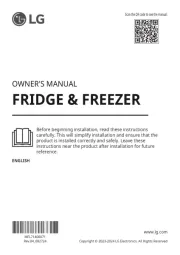
14 Juli 2025
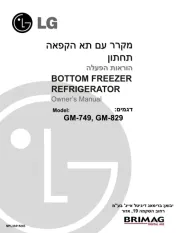
4 Juli 2025
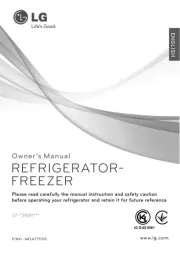
4 Juli 2025
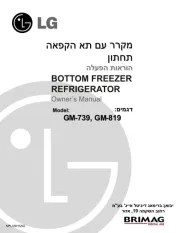
4 Juli 2025
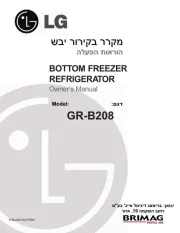
3 Juli 2025
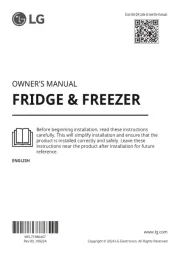
15 Juni 2025
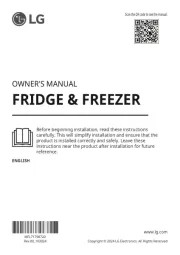
15 Juni 2025
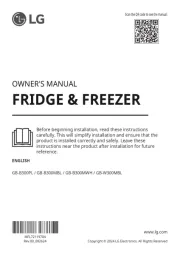
9 Juni 2025
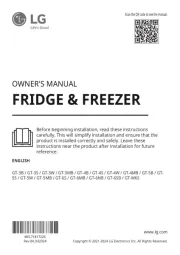
7 Juni 2025
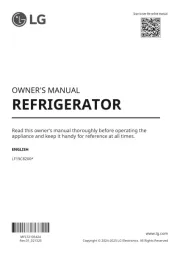
7 Juni 2025
Handleiding Koelkast
- Dellware
- Hestan
- Zanussi
- Fire Magic
- Azure
- Sedona
- Iris Ohyama
- Bellini
- Thermo-Kool
- Essentiel B
- Master-Bilt
- Landmark
- High One
- Bushman
- Juno
Nieuwste handleidingen voor Koelkast
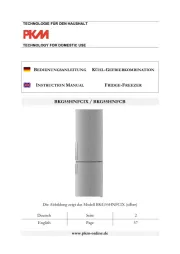
2 Augustus 2025
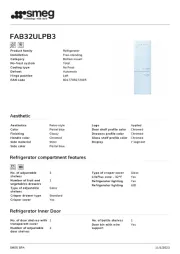
2 Augustus 2025
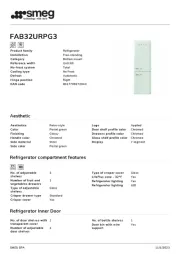
2 Augustus 2025
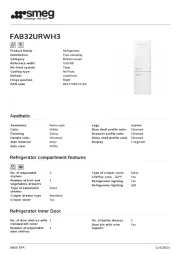
2 Augustus 2025
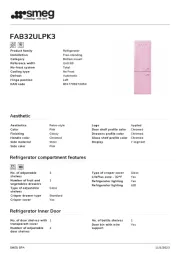
2 Augustus 2025
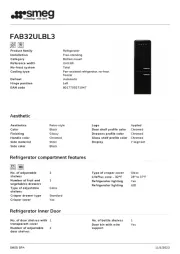
2 Augustus 2025
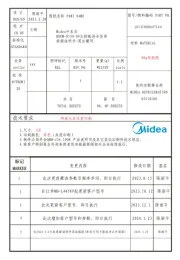
2 Augustus 2025
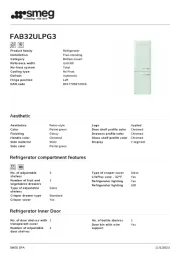
2 Augustus 2025
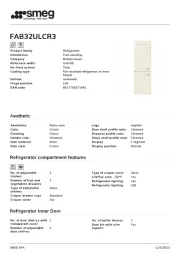
2 Augustus 2025
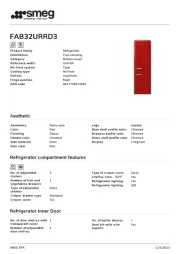
2 Augustus 2025